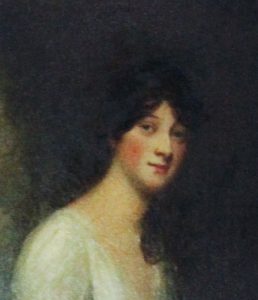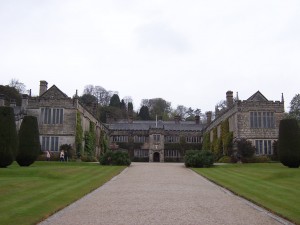In this post:
 Lanhydrock House is located 3 miles from Bodmin, Cornwall. Today, the house is presented mainly on the basis of the events and owners of the Victorian age. But Lanhydrock House is well rooted in the Regency period and can tell you the story of Anna-Maria Hunt (1771-1861) and her arduous inheritance.
Lanhydrock House is located 3 miles from Bodmin, Cornwall. Today, the house is presented mainly on the basis of the events and owners of the Victorian age. But Lanhydrock House is well rooted in the Regency period and can tell you the story of Anna-Maria Hunt (1771-1861) and her arduous inheritance.
An Arduous Inheritance
Anna-Maria had always been considered the heir of Lanhydrock House, at that time owned by her uncle, George Hunt. In the eyes of the fine society, she was a lucky heiress, the aim of every fortune-hunter. But when her uncle died in 1798, she was confronted with a tricky testament and the strange humour of Uncle George: He left her Lanhydrock, but also the shocking amount of £68,000 (£2.2m in today’s money) in debts. Uncle George’s money, his shares in mines, arrears from tin, copper and timber dues and even the furniture of Lanhydrock went to some distant cousins. Anna-Maria found herself with £100 with which to run the estate and only three people in service living in Lanhydrock: an aged housekeeper, her daughter and the gardener.
For all we know, Anna-Maria was not the type of woman to sink on a sofa with the vapours when being confronted with difficulties. And there was a slight chance to get hands on some of the money so bitterly needed to pay the debts and to make Lanhydrock a thriving estate: Her mother had inherited the family estate, Mollington Hall, when her husband had died. Anna-Maria was supposed to inherit the estate one day. But the tricky testament of her father forbade selling Mollington Hall. The only way out of this dilemma was to have a bill passed in the House of Lords that would enable the family to sell Mollington and invest the proceeds in Lanhydrock. No easy task, but Anna-Maria and her mother tackled it. The bill passed in 1802. Selling the house brought £15,000.
The Country House Rescue
Lanhydrock estate had rarely been popular with its previous owners, such as the Earls of Radnor. “It’s impossible to have a more disagreeable estate to manage”, wrote a great granddaughter of the 1st Earl of Radnor in a letter in 1754. Luckily, Anna-Maria, new mistress of the estate, was not left without support in dealing with her inheritance. At her side was William Jenkin, the steward who had been hired by her uncle to run the estate. Jenkin, described as “upright, conscientious, compassionate”, helped Anna-Maria to become a good landlord. She, in turn, was an apt pupil; eager to look after her inheritance. Both of them worked hard to make the estate profitable again, taking care that every tenant had a good patch of potatoes and that sufficient wheat was grown to provide the whole parish with bread for a year. And whenever some money was available, Anna-Maria also took care that Lanhydrock House, tending to be damp, was made dry, and she modernised the rooms.
A nasty neighbour
Besides the difficult financial situation, Anna-Maria and Jenkin had to deal with a particularly nasty neighbour, Lord de Dunstanville and his aggressive steward. Jenkin described the steward as “a man of a revengeful and tyrannical disposition”. Lord de Dunstanvill and his steward tried to snatch away some patches of Anna-Maria’s land. They intimidated her tenants and took Anna-Maria to court over a contested watercourse. Jenkin tried to find persons willing to testify on Lanhydrock’s behalf, but whoever considered doing so might wake up to find his garden hedge pulled down or the dung stolen from his field.
How to use Anna-Maria Hunt as a Character of your Novel
Anna-Maria Hunt (1771-1861) was not your average Regency lady. Unlike the rules of the Regency period dictated, she neither married in her prime nor was she a demure female. She could deal with lawyers, stewards and tight financial situations. So if you would like to include in your novel a woman who speaks her own mind and runs her estate successfully, Anna-Maria is the perfect choice. Here are more facts about her:
- Anna-Maria was born into an old and respected family in Cheshire, but the Hunts didn’t belong to the highest of the aristocracy. Anna Maria’s mother was Mary Vere Robartes, the sister of the third Earl of Radnor. She brought Anna-Maria and her sister up as ladies.
- Anna-Maria had her own opinion on everything. Rumour has it that her outspoken ways closed Royal Doors at her, so that she was never presented at Court. But Anna-Maria was not the girl to cry her eyes out about such fiddle-faddle.
- Anna-Maria was good-looking, with long brown hair. She was intelligent and energetic.
- She had a hound named “Dragon”.
- Her uncle George Hunt at Lanhydrock House had made it known to society that Anna-Maria would be his heir. He even had paid the fashionable society painter, George Romney, to paint her portrait for her 21st birthday. We don’t know why he chose to write his testament as he finally did. So, with everyone believing Anna-Maria to be an heiress, speculations ran high who, upon her coming of age, would be the lucky devil to win her hand and her money. Anna-Maria, however, chose to not to marry at all when being in her bloom – very unusual for Georgian standards.
- When she had inherited Lanhydrock, she took a keen interest in the estate. She didn’t live there all the time, but even when being in London, she was in constant contact with the steward, and she visited Lanhydrock every summer.
- In 1804, aged 33, Anna-Maria finally married. Her husband was a barrister-at-law, Charles Bagenal Agar, aged 35. As the youngest son of Viscount Clifden, his fortune was very modest and he had little expectation. The marriage settlement was quite extraordinary for the time. Anna-Maria was to have “a substantial sum of money from ‘her’ revenues, strictly for herself; to dispose of exactly as she pleased, with no interference from her husband. In addition she had £1000 per annum.” And though Charles became Lord of the Manor at Lanhydrock, it was Anna-Maria who controlled the estate. Unfortunately, the marriage lasted only for a few years. Charles died in 1811.
- Later in life, Anna-Maria found that her sound financial dealings and good estate management allowed her to enjoy luxuries. Upon her death, her wealth was estimated at £250,000 (about £10.8m in today’s money ). She left a thriving estate for her son.
Care for more Writer’s Travel Guide-stories ? Click here.
Sources:
Hitchins, Fortescue / Drew, Samuel: The History of Cornwall: From the Earliest Records and Traditions to the Present Time, Vol. 2; London, 1824
Paul Holden: “The Hunt Family, Lanhydrock House and the Regency Style”, in: Furniture History, Vol. XXXVII, 2001.
Curtis, Ann Marie: „An Accidental Heiress: The Life and Times of Anna Maria Hunt of Mollington Hall and Lanhydrock House”; in Lanhydrock Journals, Journal (2011) No.10.
Collins, Jacqueline: “The Role of the Steward as shown by the Correspondence between Anna Maria Hunt & William Jenkin”; Lanhydrock Journals, Journal (2001) No.1.
Great Britain House of Lords: Journals of the House of Lords, Beginning Anno Quadragesimo Primo Georgii Terzii, 1801, Vol. 43.

